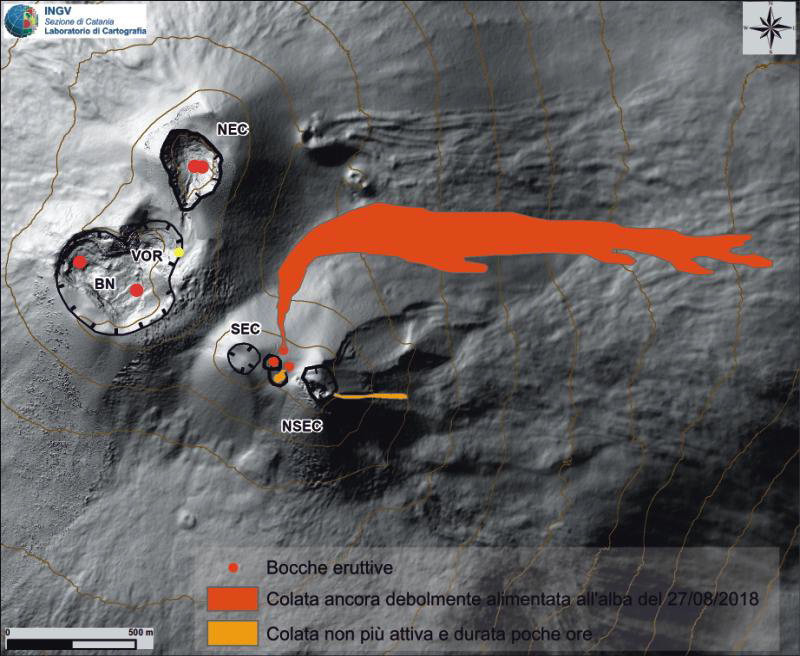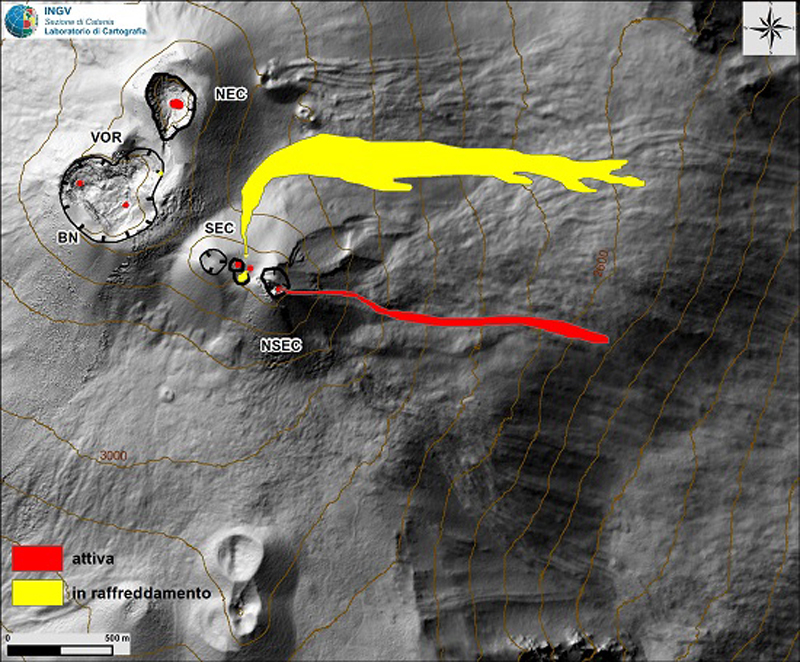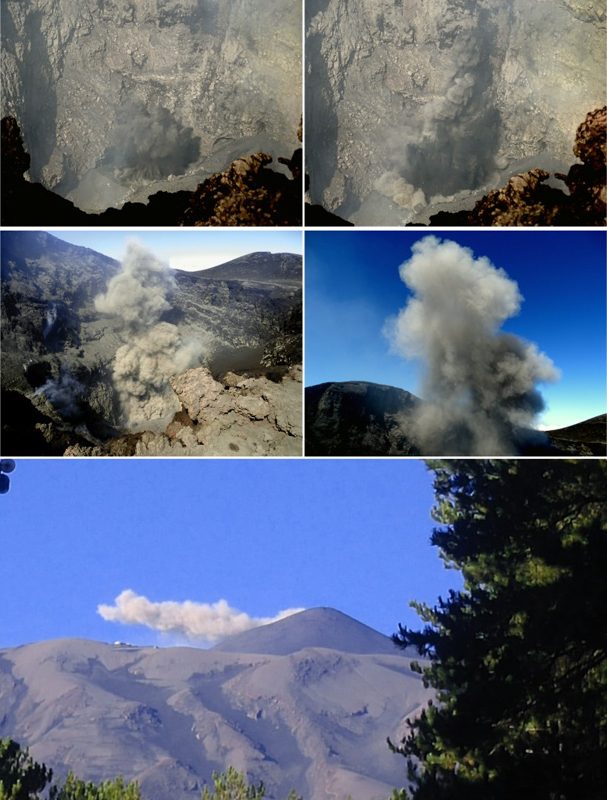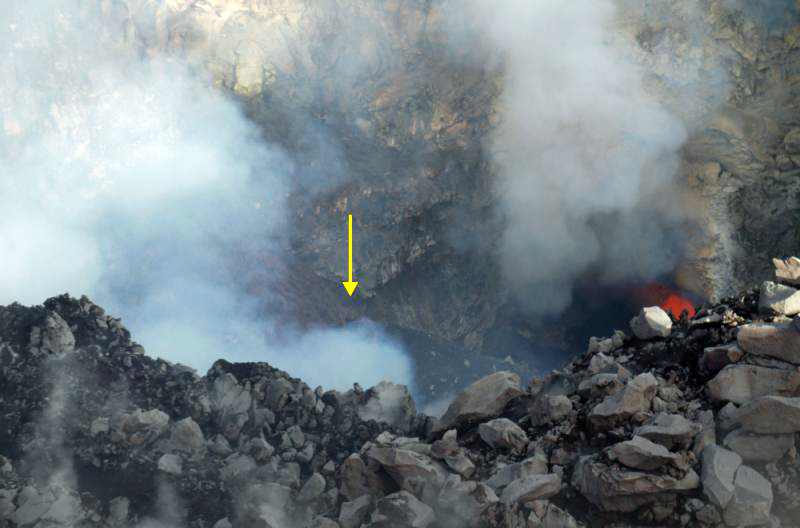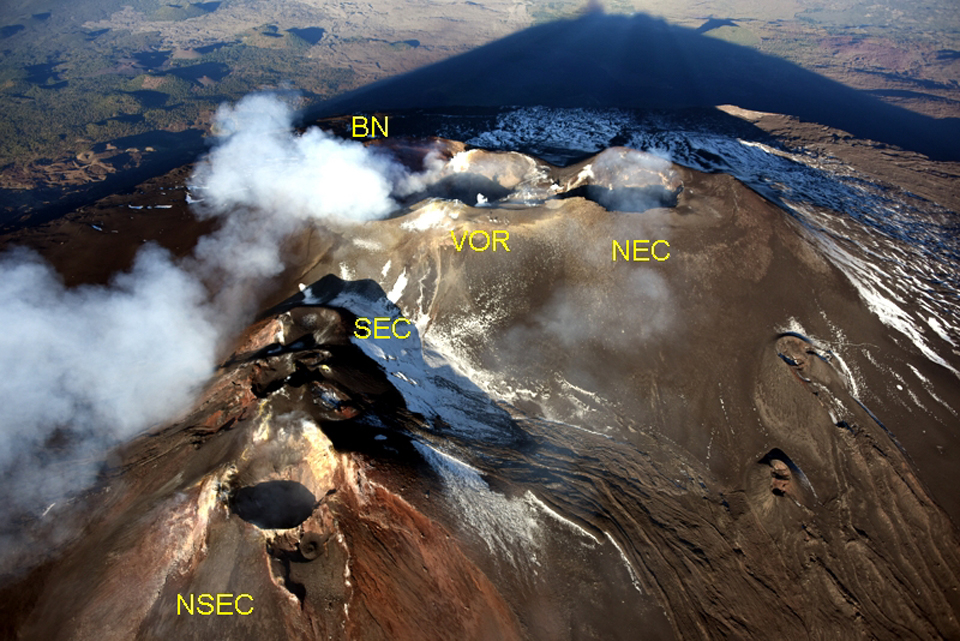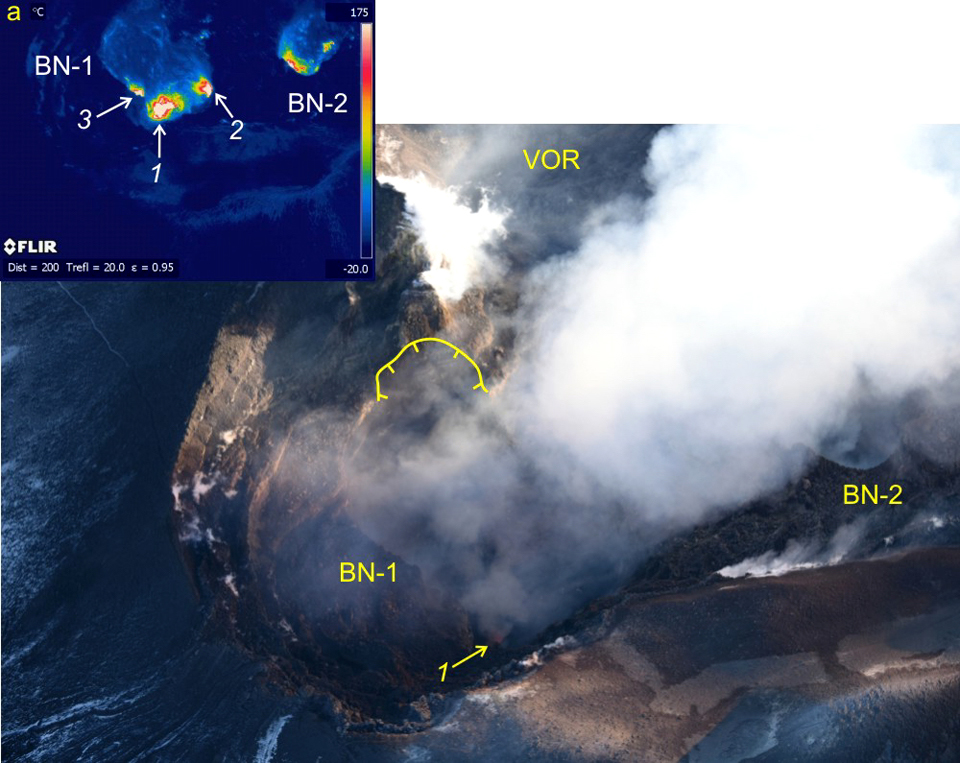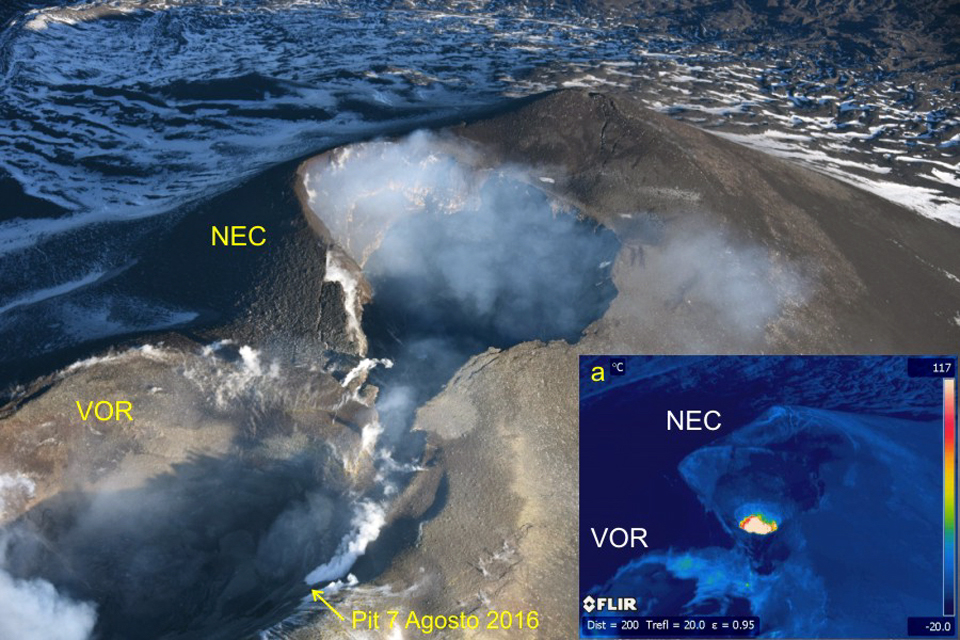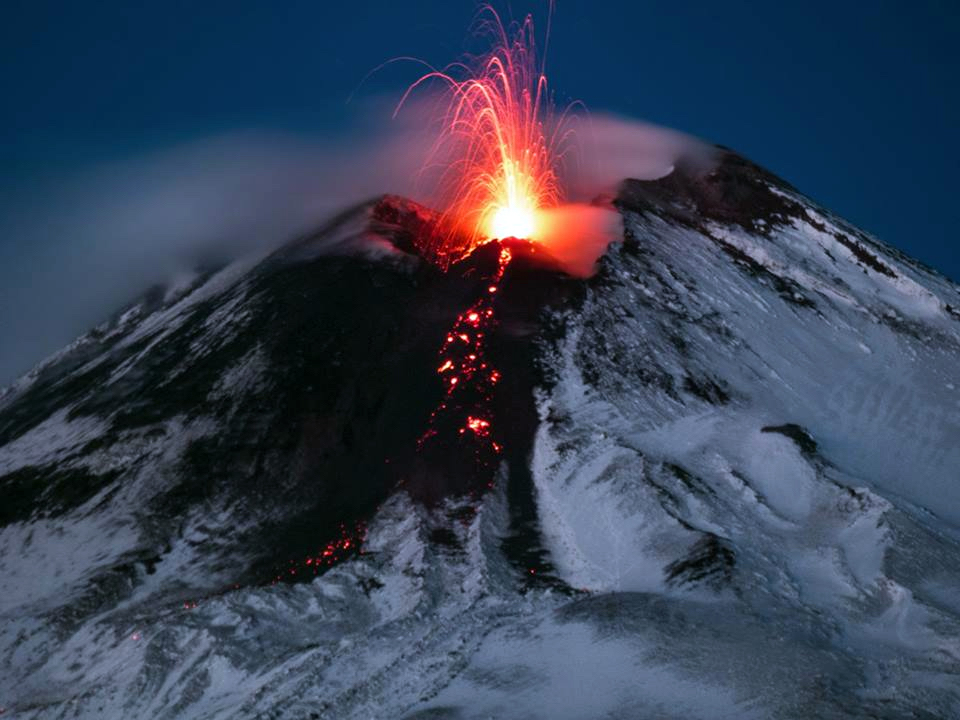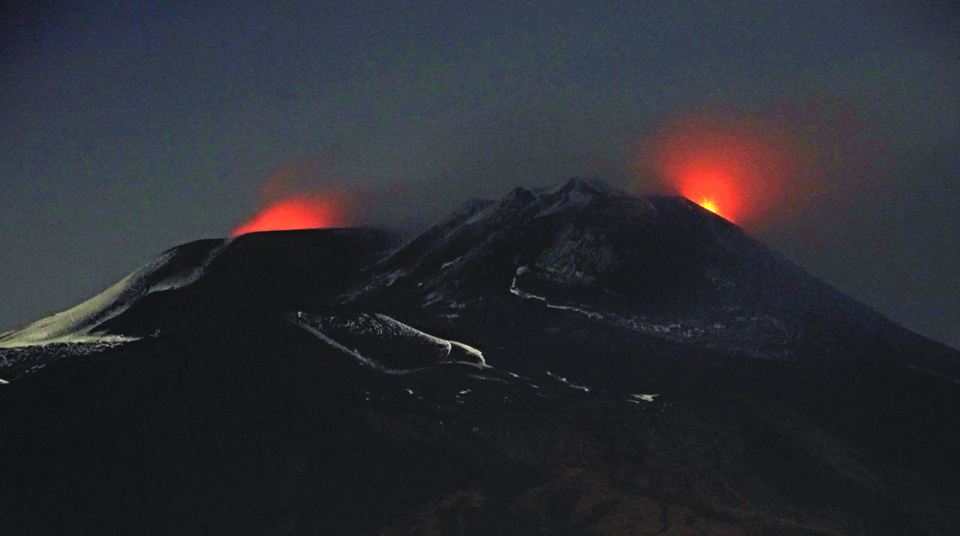Report on Etna (Italy) — December 2018
Bulletin of the Global Volcanism Network, vol. 43, no. 12 (December 2018)
Managing Editor: Edward Venzke.
Edited by A. Elizabeth Crafford.
Etna (Italy) Lava flows emerge from NSEC in late August and late November 2018; Strombolian activity continues from multiple vents
Please cite this report as:
Global Volcanism Program, 2018. Report on Etna (Italy) (Crafford, A.E., and Venzke, E., eds.). Bulletin of the Global Volcanism Network, 43:12. Smithsonian Institution. https://doi.org/10.5479/si.GVP.BGVN201812-211060
Etna
Italy
37.748°N, 14.999°E; summit elev. 3357 m
All times are local (unless otherwise noted)
Italy's Mount Etna on the island of Sicily has had historically recorded eruptions for the past 3,500 years and has been erupting continuously since September 2013 through at least November 2018. Lava flows, explosive eruptions with ash plumes, and Strombolian lava fountains commonly occur from its summit areas that include the Northeast Crater (NEC), the Voragine-Bocca Nuova (or Central) complex (VOR-BN), the Southeast Crater (SEC) (formed in 1978), and the New Southeast Crater (NSEC) (formed in 2011). A new crater, referred to as the "cono della sella" (saddle cone), emerged during early 2017 in the area between SEC and NSEC and has become the highest part of the SEC-NSEC complex. Activity during late 2017 and early 2018 consisted mostly of sporadic Strombolian activity with infrequent minor ash emissions from multiple vents at various summit craters. Lava flow activity resumed in late August 2018 and again in late November and is covered in this report with information provided primarily by the Osservatorio Etneo (OE), part of the Catania Branch of Italy's Istituo Nazionale di Geofisica e Vulcanologica (INGV).
After several months of low-level activity in early 2018, increases in Strombolian activity at several vents began in mid-July (BGVN 43:08). This was followed by new lava flows emerging from the saddle cone and the E vent of the NSEC complex in late August. Discontinuous low-intensity Strombolian activity and intermittent ash emissions were reported from multiple vents at various summit craters during September through November. In late November, renewed Strombolian activity and a new, small flow emerged from a small scoria cone inside the E vent of the NSEC crater and persisted through the end of the month. The MIROVA thermal anomaly correspond to ground observations of increased thermal activity at Etna beginning in mid-July, peaking in late August, and increasing again at the end of November 2018 (figure 222).
Low-energy Strombolian activity resumed at both of the Bocca Nuova BN-1 vents as well as the vents in the Northeast Crater (NEC) during the second week of July 2018 and continued throughout the month. The activity from BN-1 was nearly continuous, but not always visible; occasionally, lava fragments rose 100 m and could be seen outside of the crater rim. Intermittent ash emissions accompanied the Strombolian activity. Activity at NEC was characterized by strong and prolonged explosions (up to several tens of seconds), sometimes with reddish-brown ash emissions (figure 223). Three vents on the floor of NEC continued to widen due to collapse of the inner walls. A seismic swarm on 18-19 July was located between 4 and 9 km depth.
During a field inspection on 30 July INGV personnel noted activity at the three vents at the bottom of Northeast Crater; the farthest west produced ash emissions, the center produced steam, and the vent under the NE crater wall produced Strombolian activity that sent ejecta as high as the crater rim. Frequent ash emissions from NEC were observed on 3, 4, and 5 August. During the first week of August 2018 Strombolian activity also continued at BN-1 (figure 224). The webcam at Montagnola (EMOH) recorded incandescence at night from Bocca Nuova.
After several months of calm, explosive activity also resumed at the E vent of the of the New Southeast Crater, high on the E flank, in early August. An explosion in the early morning of 1 August 2018 generated a gray-brown ash plume that rose several hundred meters above the summit (figure 225). Smaller emissions occurred throughout the day, and the EMOH camera recorded sporadic Strombolian explosions at night, which continued through the first week of August.
Similar activity at BN-1, NEC, and the reactivated vent at NSEC continued through the second and third weeks of August. On 16 August 2018 a new vent opened in the BN-2 area on the E side of the Voragine (inactive since December 2015) and exhibited both degassing and Strombolian activity (figure 226). During that week Strombolian activity also continued at the NEC, but activity became more sporadic at the E vent of NSEC. During the last week of August, Strombolian activity and intense degassing continued in the western sector of Bocca Nuova (BN-1). Occasionally, lapilli fragments a few centimeters in diameter were ejected onto the S rim of the crater. Strombolian activity also continued from multiple vents at the bottom of NEC. The frequency and intensity of explosions was variable and increased significantly during 22 August, ejecting coarse pyroclastic material outside the crater rim.
Beginning on 23 August 2018 about 1800 UTC, activity resumed at the saddle cone located between the old cone of the Southeast Crater (SEC) and the new cone (NSEC). Strombolian activity, initially modest, quickly became more intense, producing almost continuous explosions with the launch of coarse ejecta up to a height of 100-150 m. At 1830 UTC, while Strombolian explosions of modest intensity were also taking place at the E vent of NSEC, a small lava flow emerged from the E vent and traveled a few hundred meters E towards the Valle del Bove. Shortly after 1830 UTC another lava overflow was also observed moving N from the saddle cone (figures 227 and 228).
Strombolian explosions of moderate intensity continued throughout the night from the saddle cone. The following morning (24 August) a small lava overflow emerged from the vent and stopped after traveling a few tens of meters towards the S flank of the NSEC cone (figure 228, small orange flow within saddle, and figure 229b). The Strombolian activity was accompanied by an abundant and continuous emission of ash, whichformed a small plume that rose a few hundred meters from the vent (figure 229c). The Strombolian activity at the saddle cone decreased gradually on 25 August.
Strombolian activity was continuing on 27 August 2018 at NSEC, and the flow to the N into the Valle del Leone began cooling after lava stopped feeding it that evening. The same day, a new lava overflow emerged from the E vent of NSEC (figure 230) and flowed E towards the Valle del Bove for about 24 hours (figure 231).
Discontinuous Strombolian activity continued from NSEC after the effusive activity ended in late August. Several loud explosions from NSEC were reported by people living near the E flank of Etna during the first week of September. Strombolian activity, modest ash emissions, and significant gas emissions were also produced by BN-1; BN-2 exhibited only continuous degassing activity. Explosive activity declined during the second week of September. Discontinuous low-intensity Strombolian activity and intermittent ash emissions from Bocca Nuova, New Southeast Crater, and Northeast Crater characterized activity for the remainder of September. During the last week of the month, NEC produced frequent gray-brown ash emissions from a vent located in the western part of the crater floor, and included jets of ash, blocks, and volcanic bombs (figure 232).
Discontinuous low-intensity Strombolian activity and intermittent ash emissions from the Bocca Nuova, the New Southeast Crater, and Northeast Crater characterized activity during all of October 2018. Two vents remained active at the bottom of Bocca Nuova (BN-1). During a visit on 16 October, INGV-OE geologists noted that the northernmost vent produced nearly continuous Strombolian activity with frequent explosions; occasionally fragments exceeded the crater rim in height but still fell within the crater. The southernmost vent, on the crater floor about 130 m from the edge, was characterized by explosive activity that produced mainly spattering which covered both the crater floor and walls (figure 233). On 25 October the webcam at Bronte recorded an ash emission from Bocca Nuova that resulted from three closely-spaced explosions. The ash was red and dispersed rapidly to the S causing ashfall near Torre del Filosofo and Rifugio Sapienza.
Strombolian activity at NSEC gradually intensified during the first week of November 2018 and was sometimes accompanied by ash emissions that rapidly dispersed, falling mainly near the vent and in the Valle del Bove to the E. Audible explosions from the activity were heard in Zafferana Etnea on the E flank. Several clear views of the summit and details of the active vents were well exposed during an overflight on a clear 9 November day (figure 234).
Three vents were visible at BN-1 during the 9 November 2018 overflight (figure 235); continuous Strombolian activity occurred at vent 1, whose fallout of pyroclastic debris remained within the crater; discontinuous Strombolian activity was observed at vent 2 associated with weak, pulsing ash emissions; only degassing activities were observed at vent 3. At BN-2, intense degassing accompanied discontinuous Strombolian activity that was associated with weak pulsating ash emissions, and several high temperature gas emission points. Scientists also observed a collapse on a portion of the northern inner wall of BN-1 from the explosion on 25 October.
Modest outgassing continued at Voragine (VOR) from the 7 August 2016 vent near the rim during November. At NEC, continuous and intense Strombolian activity from the crater floor caused pyroclastic ejecta to land outside the crater rim (figure 236). At the NSEC complex, high-temperature anomalies were visible at the NW crater edge, and the E vent of NSEC had a small scoria cone that produced discontinuous Strombolian explosions and minor ash emissions (figure 237).
A seismic swarm with over 40 events affected the W flank of Etna on 20 November 2018; the hypocenters were located between 15 and 27 km depth. A small lava flow also emerged on 20 November from the scoria cone inside the E vent at NSEC. The flow lasted for a few hours and remained inside the E vent. A new flow from the same scoria cone at the NSEC east vent appeared on 26 November accompanied by continued Strombolian activity. The flow remained high on the E flank at an elevation of about 3,200 m. Flow activity continued into the first days of December with frequent incandescent blocks moving down the NSEC E flank (figure 238). Elsewhere at Etna, Strombolian activity continued accompanied by sporadic and modest ash emissions from Bocca Nuova, the New Southeast Crater and the Northeast Crater through the end of November (figure 239).
Geological Summary. Mount Etna, towering above Catania on the island of Sicily, has one of the world's longest documented records of volcanism, dating back to 1500 BCE. Historical lava flows of basaltic composition cover much of the surface of this massive volcano, whose edifice is the highest and most voluminous in Italy. The Mongibello stratovolcano, truncated by several small calderas, was constructed during the late Pleistocene and Holocene over an older shield volcano. The most prominent morphological feature of Etna is the Valle del Bove, a 5 x 10 km caldera open to the east. Two styles of eruptive activity typically occur, sometimes simultaneously. Persistent explosive eruptions, sometimes with minor lava emissions, take place from one or more summit craters. Flank vents, typically with higher effusion rates, are less frequently active and originate from fissures that open progressively downward from near the summit (usually accompanied by Strombolian eruptions at the upper end). Cinder cones are commonly constructed over the vents of lower-flank lava flows. Lava flows extend to the foot of the volcano on all sides and have reached the sea over a broad area on the SE flank.
Information Contacts: Sezione di Catania - Osservatorio Etneo, Istituto Nazionale di Geofisica e Vulcanologia (INGV), Sezione di Catania, Piazza Roma 2, 95123 Catania, Italy (URL: http://www.ct.ingv.it/it/ ); MIROVA (Middle InfraRed Observation of Volcanic Activity), a collaborative project between the Universities of Turin and Florence (Italy) supported by the Centre for Volcanic Risk of the Italian Civil Protection Department (URL: http://www.mirovaweb.it/).








